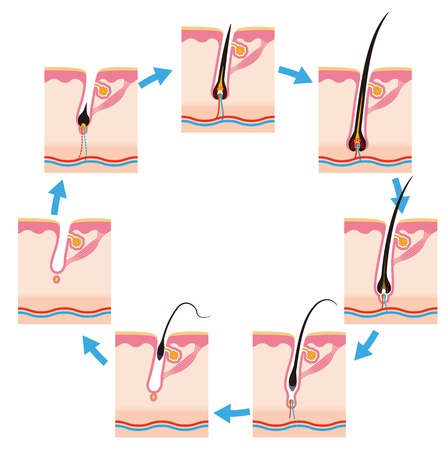Hair Cycles: How it Grows and Why it Sheds

You wash your hair. Brush or comb it. But do you understand it? Understanding the hair growth cycle will help you grasp and solve many of the problems you can encounter with your hair.
Hair grows from the follicle, or root, under the skin. Blood vessels at the follicle’s base give your hair the nourishment it needs to grow. Between starting to grow and falling out years later, each hair passes through four stages: anagen, catagen, telogen, and exogen.
The anagen phase.
During the anagen phase, growth cells in the papilla—the bulbous structure at the base of the follicle—rapidly divide and produce the hair shaft, which becomes keratinized—filled, that is, with the protein keratin, which makes our skin and hair waterproof— as it pushes up and out of the hair follicle into the skin pore. At the same time, the hair follicle grows down into the deeper levels of the dermis, seeking nourishment.
Your hair grows about half an inch a month—faster in summer than winter. The anagen phase typically lasts 3 to 5 years, yielding 18 to 30 inches of hair, if uncut. Some populations vary. Asians’ anagen phases can run 7 years, easily producing yard-length hair.
The catagen phase.
This two- to four-week transitional phase follows the anagen. It’s part of a renewal process where the hair follicle degrades and the hair stops growing but doesn’t fall out. The hair follicle shrinks to about a sixth of its usual size. The papilla breaks away, the bulb detaches from the blood supply, and the hair shaft gets pushed up as the follicle disintegrates.
The telogen phase.
In this rather quiet renewal phase, your hair simply rests. Little happens, your follicle remaining inactive for as much as three months.
The exogen phase.
Sometimes it's considered a part of the telogen process, this phase is conceptually simple: hair falls out.
Every one of your hairs is at its own stage in the repeating growth cycle. Over time, the length of the “youthful” anagen stage decreases. Thus your hair may become weaker and thinner after each cycle. That’s why it’s important to ensure your diet is rich in specific nutrients to maintain normal, healthy hair growth. Here’s how it all works.
Hair loss and thinning.
These problems occur when your growth cycles get disrupted. Typical causes: metabolic imbalance, illness, improper nutrition, or changes in diet.
One example: A month or six weeks after you experience a high fever or you’ve changed your diet, you can lose a bunch of hair. The fancy term: telogen effluvium. Cause: Your anogen phase gets cut short, and many hairs enter the telogen phase all at once.
It’s important your hairs all get to spend enough time in their anogen (growing) phase. If your growth cycle is often challenged, or goes unsupported, you may find your hair won’t grow as long or as well as it once did.
Out with the old … in with the new.
Gaining new, fresh hair means losing old hair. That’s life. When you start using a product like our Scalp Tonic, you stimulate the hair follicle to start producing hair. This means in turn that, when the follicle starts growing a new hair, it must first shed the old hair, still attached.
You may get the impression you’re shedding more than usual—which you are, temporarily. Take this shedding is a positive sign that you’re responding well to treatment.
There’s an apparent irony in the fact that people responding best to treatments often lose the most hair, to start with. Some panic, and actually stop treatment when they should be staying on it. One guide: Shedding should last no longer than 4 to 6 weeks. But it is quite normal to lose a hundred hairs or more daily in any event.
Cause of excess shedding.
Stress is a common cause of excess shedding. Quick weight loss, giving birth, losing a job, divorce, death of a loved one, caring for a sick family member, high fever, recovery from surgery, ceasing birth control—these and other factors can produce hair loss. That loss usually occurs weeks or months after the stressing event. If the stressful cause has ceased, you may not connect it with the hair loss. As your body adjusts, the excess shedding likely stops, and within a few months, your hair will tend to return to normal fullness. Long-lived stress, can lead to long-term shedding.
Understand your hair before you worry.

